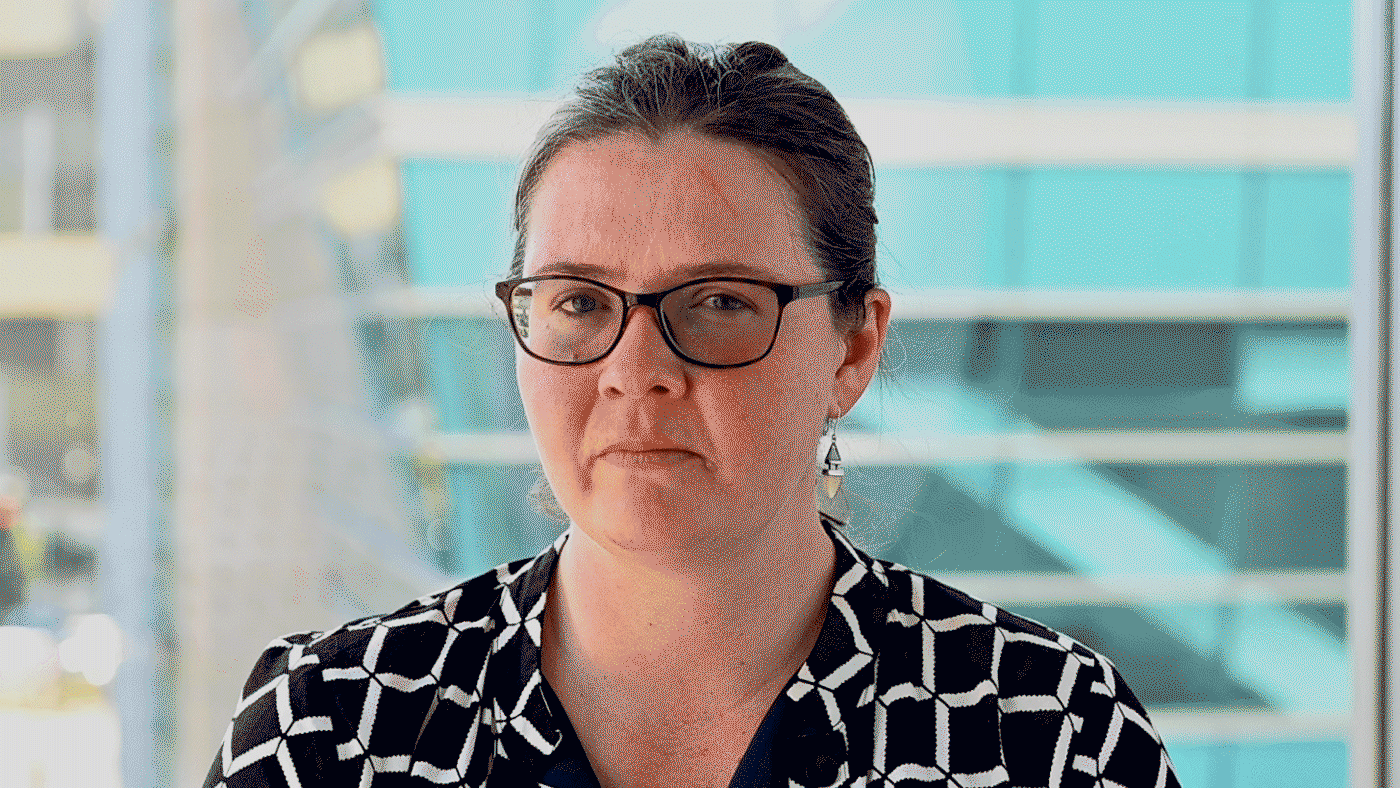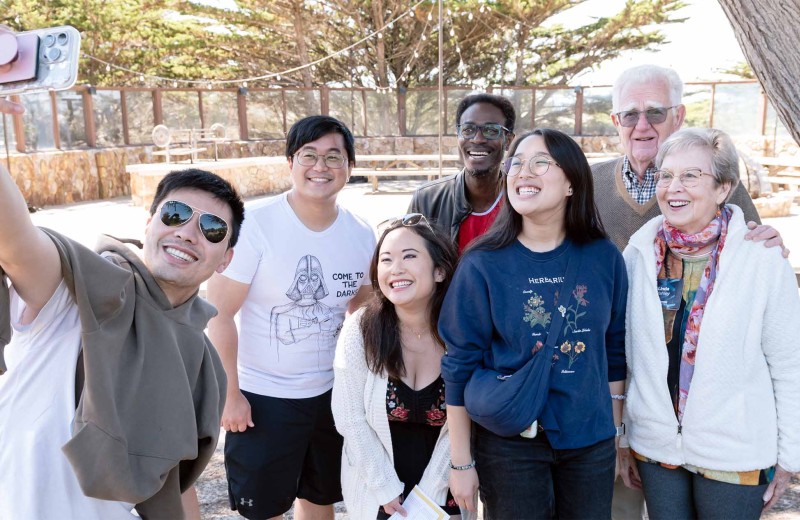Gladstone NOW: The Campaign Join Us on the Journey✕

Britta Lindquist shares what led her to epilepsy research, the scientist she'd most like to meet, and how she spends her time outside of work.
Born and raised in Santa Fe, New Mexico, Britta Lindquist (she/her), MD, PhD, completed her undergraduate degree in biochemistry at Harvard University. After college, she lived and worked in Germany, teaching in a middle school special needs classroom at Munich International School. During this time, her interest in clinical neurology was sparked as she saw the concrete, day-to-day problems that students encounter as a result of their learning differences.
Lindquist went back to her home state for medical school at University of New Mexico, where she completed her MD/PhD in the lab of Bill Shuttleworth, studying how an acute brain injury can start a wave of neuronal malfunction.
Currently, Lindquist is a clinical fellow in the lab of Jeanne Paz at Gladstone, as well as a clinical fellow at UC San Francisco and the Chan-Zuckerberg San Francisco General Hospital and Trauma Center.
What brought you to Gladstone?
I joined Gladstone in order to work with Jeanne Paz, based on her reputation as an electrophysiologist working on epilepsy and her pioneering techniques of optogenetics and genetic ablation that are essential for dissecting circuits and understanding seizure initiation, maintenance, and termination.
What do you like about Gladstone?
I appreciate the collaborative possibilities at Gladstone. Everyone is working at the top of their field, yet everyone is approachable. The size of Gladstone is manageable enough that you have a chance to walk by a bench and strike up a conversation with someone that leads to exciting pilot experiments.
Were you interested in science as a child?
I was always the kid climbing trees, playing in the arroyo, intently observing beetles and lizards, or dragging a magnet through the sand to collect iron ore. The education system in New Mexico can be patchy, so a lot of my exposure to science was informal and arose from the curiosity of exploring the natural environment around me.
For a long time I thought I would be a botanist and surround myself with plants and trees. As I got older, I found opportunities to engage with science more formally, and had summer jobs at the Los Alamos National Labs, first in the ecology group then in the biophysics group.
Why did you decide to go to medical school?
I first decided to go to medical school with the intent to become a child neurologist. Once I was in med school, I asked too many questions for an MD student, and the MD/PhD director convinced me to do a combined MD/PhD degree.
I was lucky to join Bill Shuttleworth’s lab, where I fell in love with science. My labmates pushed me and inspired me. We shared the thrill of discovery and prodded each other to do ambitious and decisive experiments that could prove our pretty models wrong. I never got harder questions at a conference than I faced every Thursday at our lab meetings.
Can you describe your current research project?
The vast majority of seizures end on their own, and we don’t really know how or why. I’m working to understand how seizures end.
There are probably multiple redundant processes that promote seizure termination. Every now and again, all these processes fail and a seizure doesn’t end. It evolves into status epilepticus, which is a medical emergency. Untreated, it can cause brain damage.
If we understood exactly what the normal processes are that promote seizure termination, we could better treat status epilepticus.
How did you decide to work on epilepsy?
I remember the first postictal patient I saw on my neurology clerkship—postictal refers to the state of confusion that follows a seizure. He was densely aphasic—he couldn’t name colors, and couldn’t pick the word “knuckles” from a list of “buckles, knuckles, or nickels.” He just said “yes” to all questions. I was fascinated that there was some process capable of shutting down his entire language cortex, even though the seizure was over.
More recently, I have had a series of patients with refractory seizures, who come to the ICU with status epilepticus and it takes lots of medication to break the seizures. We need better treatment targets.
What or who influenced your decision to work in science?
When I was in high school, I used to come home for lunch and watch reruns of the Charlie Rose show on PBS with my dad. One day, Eric Kandel was being interviewed, around the time he got the Nobel prize in physiology or medicine. He was explaining the mechanisms of learning and memory in a type of sea slug called Aplysia. He vividly described how one experiment led to another. The idea that a mere mortal could chip away at the secrets of the brain was a paradigm shift. Before that, I subscribed to the nihilistic attitude that “if the human brain were simple enough to understand, we would be too simple to understand it.”
What do you do when you are not working?
I enjoy playing outdoors—running, biking, hiking, climbing, and skiing. I also recently got a piano so I can play music in my free time.
If you could learn to do anything, what would it be?
I’d love to learn to surf and play the guitar—not at the same time!
What is your hidden talent?
Intensity of focus. That’s hardly unique, though. And I’m not sure if it’s a feature or a bug!
If you could meet any scientist from any point in time, who would it be and why?
Marie Curie. I read her biography, written by her daughter Eve. She was a lucid and uncompromising thinker, an experimentalist rather than a theoretician. She retained her humility and her humanity, and used her notoriety to improve the world around her. She actively engaged with the suffering and social policy challenges of her time.
Want to Join the Team?
Our people are our most important asset. We offer a wide array of career opportunities both in our administrative offices and in our labs.
Explore CareersMeet Gladstone: Oscar Yip
Meet Gladstone: Oscar Yip
Oscar Yip is advancing Alzheimer’s research in Yadong Huang’s lab at Gladstone while drawing inspiration from his family, community, and his broader goal of helping patients.
Graduate Students and Postdocs Profile Alzheimer’s DiseaseFrom Mentorship to Legacy: Creating Opportunity for Early Career Scientists
From Mentorship to Legacy: Creating Opportunity for Early Career Scientists
Robert and Linda Mahley’s commitment to trainee development continues through Gladstone’s annual Career Advancement Awards.
Graduate Students and Postdocs HistoryWhen Brain Cells Talk: NOMIS-Gladstone Fellow Yuliya Voskobiynyk on Decoding Microglia’s Secret Signals
When Brain Cells Talk: NOMIS-Gladstone Fellow Yuliya Voskobiynyk on Decoding Microglia’s Secret Signals
NOMIS–Gladstone Fellow Yuliya Voskobiynyk, PhD, shares her journey from Ukraine to Gladstone and how her research on microglia could shed light on brain function and diseases like epilepsy and Alzheimer’s.
Graduate Students and Postdocs Profile Neurological Disease NOMIS



